
One of the top reasons people love succulents is because they’re low maintenance. Yet, many people miss the beautiful flowers that bloom on other plants. Thankfully, there are many pretty succulents with flowers that give you the best of both worlds.
The Desert Rose, and Sunrise plants are some of the most popular flowering succulents. They’re relatively easy to care for and produce beautiful flowers. Other options like the jade plant and crown of thorns are also good alternatives.
Let’s take a look at 31 different succulents with flowers. You can find a succulent with pink flowers, orange flowers, blue flowers, and more. Whatever your tastes, region, and ability, there’s a flowering succulent for you.
1. Adenium obesum ‘Desert Rose Plant’
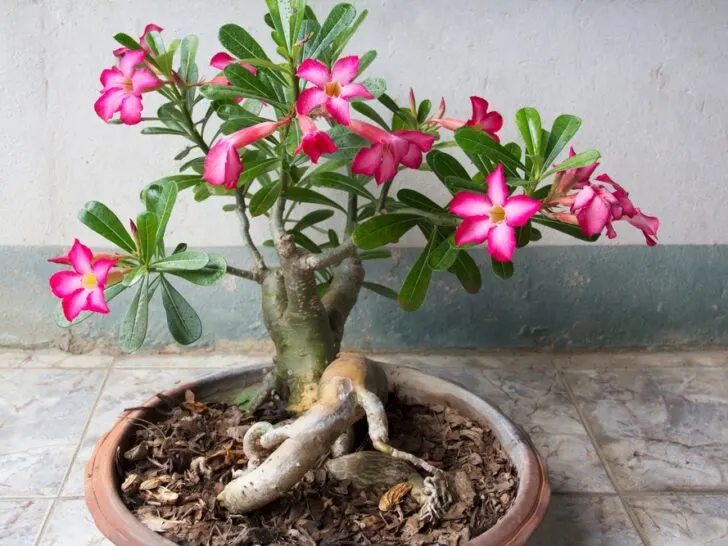
Adenium obesum is also known as the desert rose, mock azalea, Sabi star, or impala lily. This succulent looks a lot like a tree, and many people buy one as an easier alternative to a bonsai.
During the summer, they produce lily-shaped flowers that can be pink or red. Outdoors or in the wild, these plants can grow up to 6’9 (205 cm) tall! However, indoor potted plants are much less likely to reach these heights.
Like trees, these plants produce sap from their stems. This sap is highly toxic to animals and humans so exercise caution if you have pets or young children.
Seek medical attention immediately if you, your pet, or your child ingest any part of this plant.
2. Anacampseros telephiastrum variegata ‘Sunrise’

Anacampseros telephiastrum variegata, also known as the ‘sunrise succulent,’ is a small plant that doesn’t need as much direct sunlight to thrive as other succulents. Their compact size and relatively low sunlight needs make them great for apartments and offices.
In the summer, the sunrise succulent may sprout pale pink or light purple flowers on a branching stem that grows from the center of the succulent’s base rosette. Flowers are large compared to the main plant’s size. Each flower can be up to 1.4 inches (3.5 cm) in diameter.
3. Calandrinia spectabilis ‘Rock Purslane’

Calandrinia spectabilis was reclassified as cistanthe grandiflora better to distinguish it from another Chilean plant species. However, its common name is still rock purslane. You may find plants for sale under either taxonomic name.
As the name implies, rock purslanes naturally grow between rocks. They’re an excellent choice to beautify a rock garden. Due to their size, I only suggest them as an outdoor plant.
These large, bush-like succulents can grow up to 4 feet (121 cm) wide and 1 foot (30 cm) tall. Each rosette sprouts a 2 ft (60 cm) stem that produces vibrant fuschia poppy-shaped flowers in summer.
Rock Purslane blooms will only last one day. However, they regularly produce new flowers throughout the season.
4. Calico Kitten Crassula
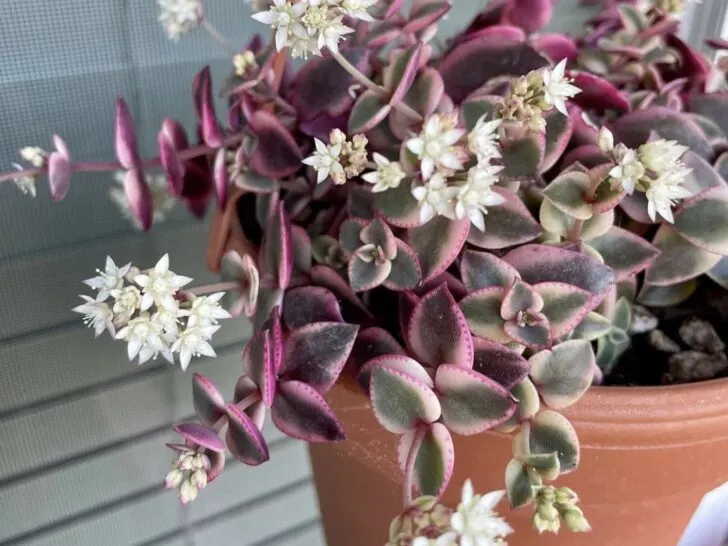
Crassula pellucida, better known as the calico kitten crassula, is a bushy succulent with a mix of green and purple leaves. They may produce tiny, delicate star-shaped creamy white flowers during spring or early summer.
They make good indoor plants but can be fussy about sunlight. For this reason, I recommend placing them in a well-lit room with windows. You should avoid putting one in a bathroom.
Mature plants grow to about 6-12 inches (15-30 cm) in height. They’re ‘spill plants,’ which means they’ll hang over the sides of their pots instead of growing upwards.
5. Crassula ovata ‘Jade Plant’

Crassula ovata, or jade plants, are a popular tree-like succulent. One of the reasons why they’re so popular is because they’re very easy to care for, even by succulent standards. They’re also long-lived and are sometimes passed down between generations.
The oldest recorded jade plants live up to 100 years!
Under the right conditions, they may produce small star-shaped pale pink or white flowers in late winter or early spring. Jade plants are usually kept as indoor plants but can be placed outside on patios.
Jade plants are dangerously toxic to cats and dogs. They’re also mildly toxic to humans. For a human, eating a leaf will cause nausea. For a cat or dog, it’s deadly, so take precautions or avoid it altogether if you have curious pets.
6. Echeveria afterglow
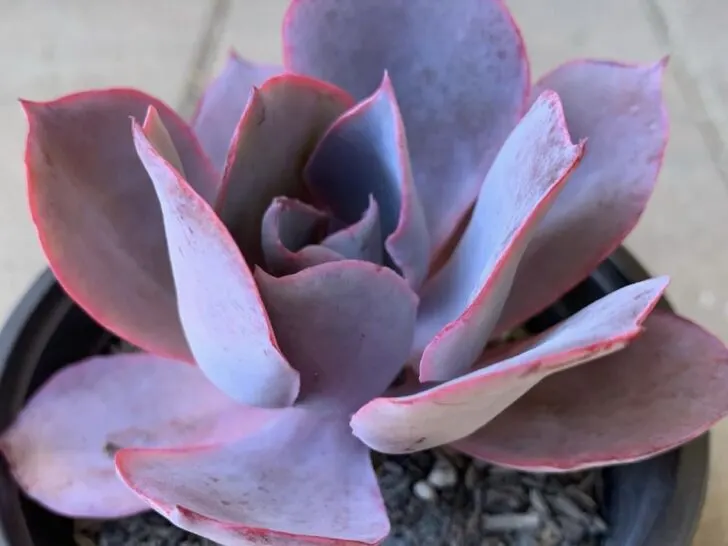
Echeveria afterglow is a bluish-lavender rosette-shaped plant with pale pink edges. In summer, the center of the rosette may sprout a short stem that produces bright orange or red flowers. Sometimes, these flowers appear between leaves away from the center.
Many gardeners remove these flowers because they can stunt the plant’s growth. However, if you want the flowers, you can let them grow without damaging the plant. It’s all a matter of preference. When placed outdoors, their flowers can attract hummingbirds.
7. Echeveria can can
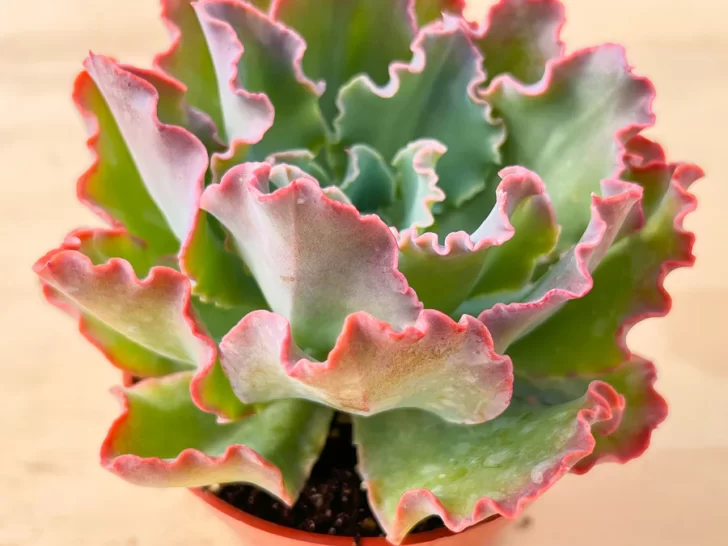
Echeveria can can is a cabbage-shaped succulent with ruffled edges. It’s usually green and dusty pink, but it may change colors with age or under different conditions. They may sprout stems that produce yellowish-red or reddish-pink flowers in summer.
The echeveria can can grow to about 14 inches (35 cm) in diameter. It’s best as an indoor potted plant but can work in a rock garden. These plants are a human-created hybrid of unknown parentage. You won’t find them in the wild, but they can handle a range of conditions.
8. Echeveria elegans ‘Mexican Snowball’
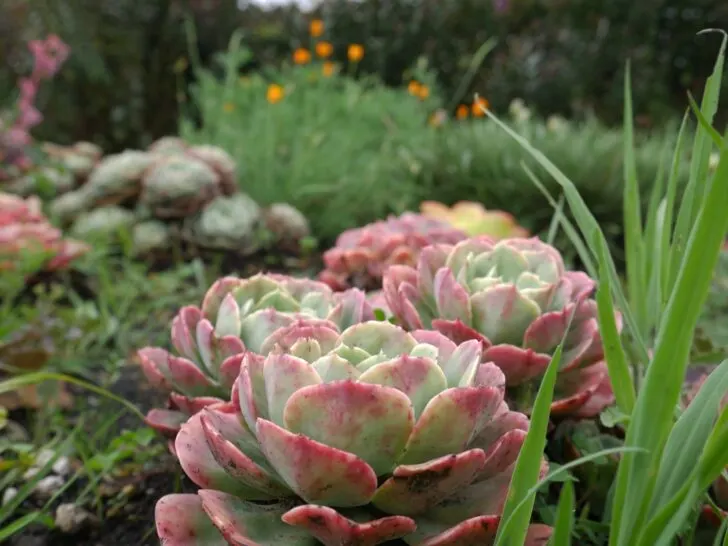
Echeveria elegans is also called the Mexican snowball, Mexican gem, or white Mexican rose. These silvery-blue rosette-shaped succulents sprout lantern-shaped pink flowers with yellow tips. Blooms occur in late winter or early spring but can appear in summer.
Mexican snowballs are beginner-friendly and can handle a wide range of conditions. They work as indoor or outdoor plants. Flower stems usually reach about 8-12 inches (20-30 cm) in height. The base rosette typically reaches a 5-inch (15 cm) diameter.
9. Echeveria laui
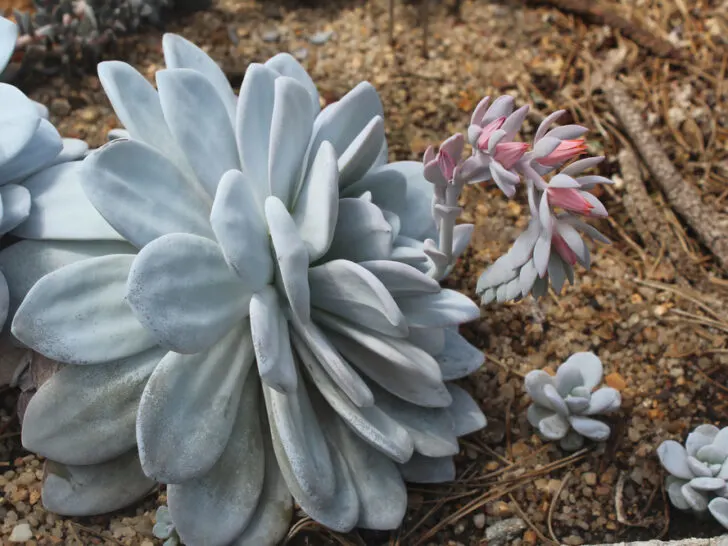
The echeveria laui is a pale blue rosette-shaped succulent that may turn pale pink under stress. Between summer and early fall, they may sprout stems that produce small lantern-shaped pale pink or peach flowers.
Lauis do best in partial shade. As a result, keeping these indoor plants near an east or west-facing window is typically a good idea. Lauis can bloom several times throughout their lives, but the process consumes a lot of energy. Old plants may not survive after blooming.
10. Echeveria ‘Neon Breaker’
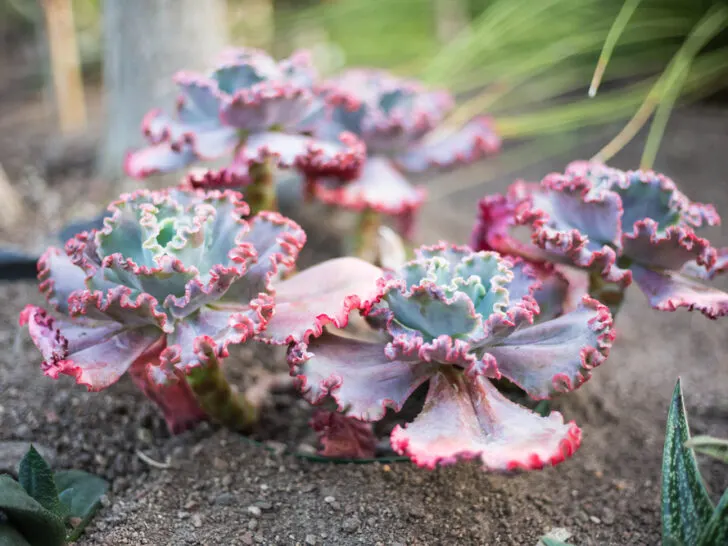
The neon breaker is a bluish-green or purple succulent with pink flowers that sprout from purple stems in late summer or early fall. These flowers will be pastel pink at first and gradually deepen to a vivid magenta throughout the season.
Neon breakers can bloom more than once within the same year. However, this is an energy-consuming process. You may want to periodically remove the stalks and enjoy the blooms at other times to conserve the plant’s energy.
11. Echeveria ‘Perle von Nurnberg’

The Perle von Nurnberg is a German hybrid plant that’s often shortened to PVN. They’re light purple rosette-shaped succulents with a pearlescent sheen. In summer, they may grow reddish-pink stems that sprout coral-colored lantern-shaped flowers with yellow centers.
PVNs bloom several times throughout their lifespans. Usually, they sprout 5 or 6 flowering stems each year. Many people use rosettes or blooms in floral arrangements. The PVN is sought after for wedding bouquets for its striking pearly shine.
12. Echeveria ‘Pink Champagne’
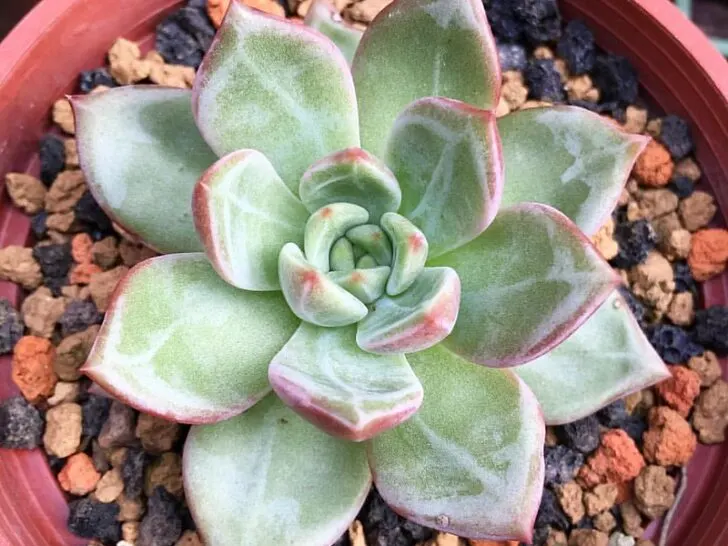
Pink champagne is a lotus-shaped Korean hybrid that ranges from silvery blue to mint green. However, as the name implies, it can turn pastel pink under stress. Its flowers are a striking hue of vivid orange, and they usually bloom in late summer or early fall.
The base rosette is typically 10 inches (25 cm) in diameter. They make beautiful centerpieces as long as the room has enough light to keep them healthy. This succulent is a rare find, making it highly sought after by collectors.
13. Echeveria shaviana ‘Pink Frills’

Echeveria shaviana is also known as pink frills or Mexican hens and chicks. It’s a purple or silvery-blue succulent with pink-highlighted ruffled edges. This plant may sprout 12-inch (30 cm) stems during summer, producing pink lantern-shaped flowers with yellow centers.
When this succulent blooms, all of the flowers will grow on one side of the sprouted stem. Try strategically placing your plant near a windowsill to control where the blooms grow. Typically, flowers prefer to face the sun. This won’t guarantee the location of your blooms, but it can encourage it.
14. Echeveria taurus
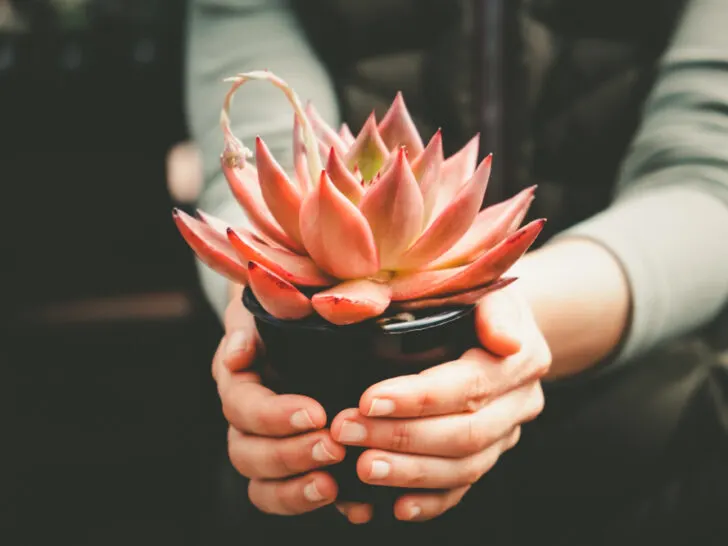
Echeveria taurus is a multicolored succulent that is also known as the molded wax plant. They may sprout stems that produce flowers during the summer months. These lantern-shaped flowers can be blue, red, orange, or yellow.
The echeveria taurus is beautiful, but it’s also rather tender. I recommend growing it indoors because you’ll have more control over its environment. They can work as patio plants in some regions if it doesn’t get too cold.
Each leaf on the base rosette is triangular, and each point is a bit sharp. Be careful when you handle these plants.
15. Echinopsis chamaecereus ‘Peanut Cactus’

Echinopsis chamaecereus is commonly called the peanut cactus due to its shape. These cacti grow to be about 6 inches (15 cm) tall and have a curvy peanut shape. Multiple stems grow in clusters, and each stem may produce a reddish-orange flower in spring or summer.
These flowers are one of the most attractive features of the peanut cactus. Each bloom has a 2-inch (5 cm) diameter, multiple spear-shaped petals layers, and an elongated stigma.
Additionally, peanut cactus spines are soft. So you don’t have to worry about them poking you. However, bear in mind that these soft spines are bristly. They may cause itching or discomfort in people with sensitive skin.
16. Echinopsis ‘Rose Quartz’

The rose quartz cactus is a hybrid created by crossbreeding Echinopsis chamaecereus and Echinopsis lobivia. Like the peanut cactus in its parentage, it has an elongated peanut shape. Each stem can bloom 20-30 pink or reddish-orange flowers in spring.
The rose quartz cactus is beginner-friendly and great if you want a succulent with lots of flowers. Flowers are 3 inches (7 cm) in diameter, and the cactus stem grows to about 6 inches (15 cm). They make beautiful centerpieces or potted patio plants.
17. Epiphyllum Hybrids ‘Orchid Cactus’
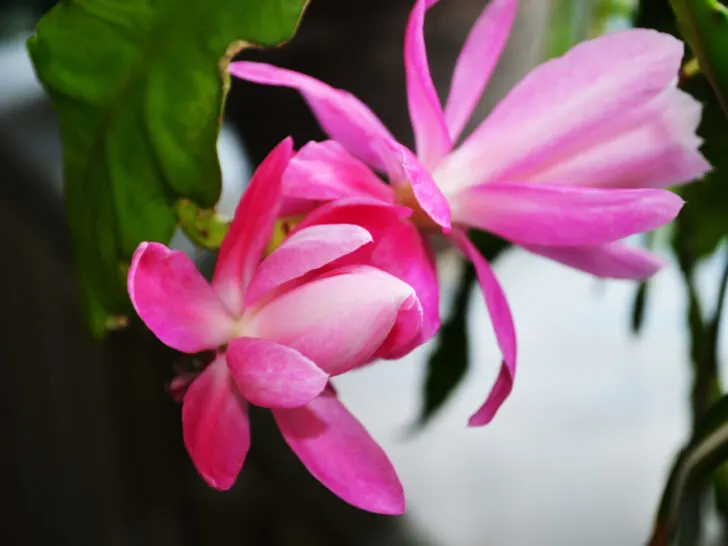
There are dozens of different epiphyllum hybrids out there. The first hybrid was bred in the 1840s, and botanists have continued to make more. These succulents were specifically bred for their vivid flowers. They’re also known as the orchid cactus or climbing cactus.
The plant’s sizes and flower colors vary. However, there are a few common features between orchid cacti.
All of them bloom in spring or summer and include broad, leaf-like stems called cladophylls. In all types, blooms are only open at night.
Some types feature broad-petaled flowers, while others bloom flowers with spidery spear-shaped petals. Flowers typically grow on long stems that hang off the side of the plant’s pot. Flower colors include:
- White
- Pink
- Red
- Yellow
- Orange
- Purple
Some epiphyllum hybrids also feature multicolored flowers. For example, the clown variety has white and pink flowers.
18. Euphorbia milii ‘Crown of Thorns’
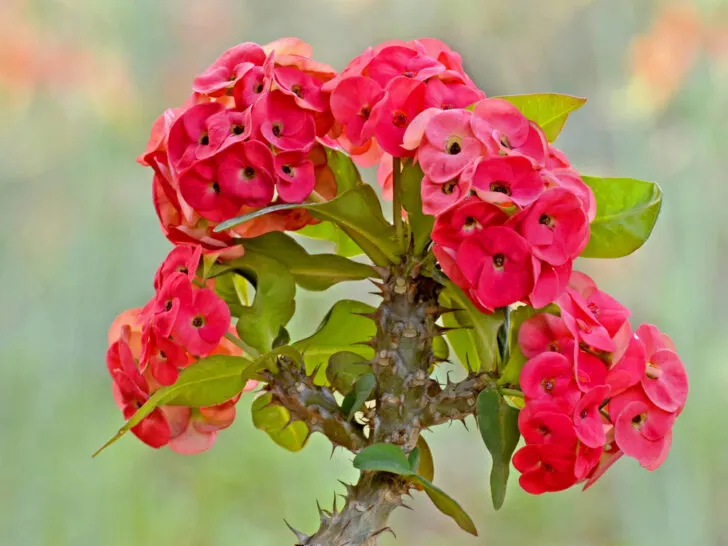
Euphorbia milii is commonly known as the crown of thorns or the Christ plant. They have dark, thorny stems similar to a rose bush. Each stem sports broad emerald green leaves and cute little round flowers that may be pink, red, yellow, or orange. When cut, the stem leaks a milky sap, which is highly toxic to humans and animals.
These plants are very small and look great as hanging decorations as they only grow to about 1 inch (3 cm) tall.
Always wear gloves when you prune a crown of thorns. The toxic sap is corrosive to human skin. Getting this sap in your eyes can also cause temporary blindness, so avoid touching your face with your gloved hands when you prune this plant.
Because this sap is dangerous to animals, I recommend growing it indoors to protect your backyard wildlife. Of course, keep it away from any children or pets.
19. Graptopetalum pachyphyllum ‘Bluebean’

Graptopetalum pachyphyllum is commonly referred to as blue beans or the ghost flower succulent. These clusters of bulbous leaves may sprout stems in spring or summer. Stems produce white lantern-shaped flowers with red highlights.
Sometimes, these flowers are pink with yellow tips instead. They can flower multiple times throughout their lifetimes. The plant is non-toxic but may irritate sensitive skin.
20. Graptopetalum paraguayense ‘Ghost Plant’
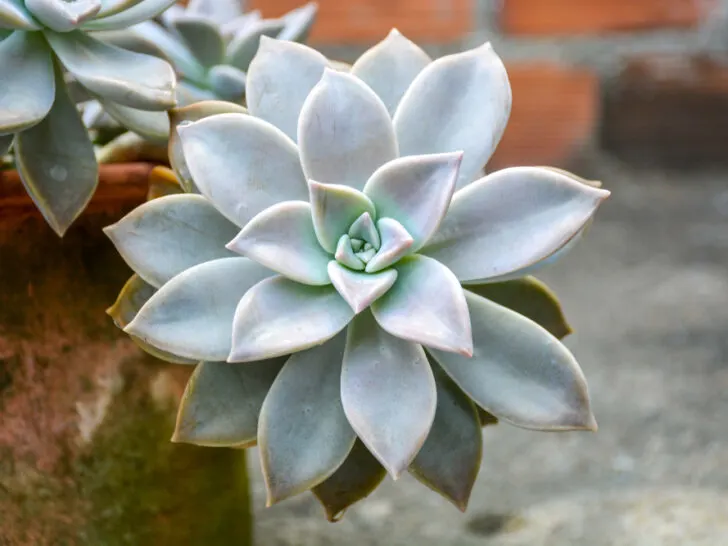
Graptopetalum paraguayense is a blue-gray lotus-shaped succulent with a pearlescent sheen. It’s also commonly called the ghost plant, mother or pearl plant, or ghostie. They may sprout 2 or 3 stalks with white and yellow star-shaped flowers with red stripes.
Ghost plants can bloom multiple times in their lives, but only once a year. Usually, flowering occurs in spring. However, blooms can occur anytime throughout the year. These plants are evergreen, so blooming is still possible in the dead of winter.
21. Graptoveria ‘Douglas Huth’

This echeveria-graptopetalum hybrid is a greenish-gray succulent with pink flowers that bloom in spring. These flowers appear on long stems that grow between the leaves on the base rosette.
Douglas Huth is a small succulent. It typically grows to a 7-inch (20 cm) diameter. This plant works better as an indoor potted plant. It can survive in full or partial sunlight, so you have a lot of options on where you can put it.
22. Gymnocalycium mihanovichi ‘Ruby Ball’
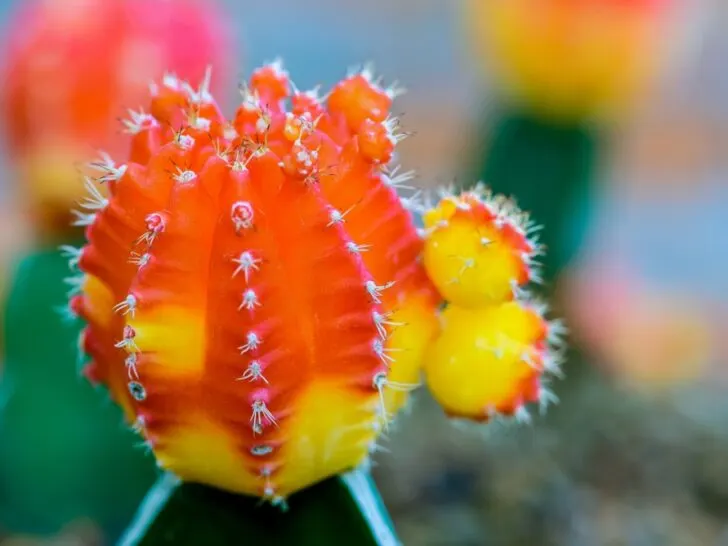
Gymnocalycium mihanovichi is commonly called the ruby ball, red cap cactus, or moon cactus. It’s a unique-looking grafted cactus with a green rootstock and a red, orange, or yellow scion. The scion can bloom purple, red, or pink daisy-shaped flowers.
Bear in mind that flowering is rare with this cactus. It can happen but isn’t as common as it is with other flowering succulents. If your scion grows buds, it’s more likely that these are offshoots, not flowers. You can graft scion offshoots to a new rootstalk if desired.
It may not be the best choice for someone who wants to guarantee flowers, but it’s still a unique succulent that almost looks like something from a Dr. Suess book. Therefore, it’s an excellent addition to many collections and makes a great talking piece.
23. Kalanchoe blossfeldiana ‘Flowering Kalanchoe’
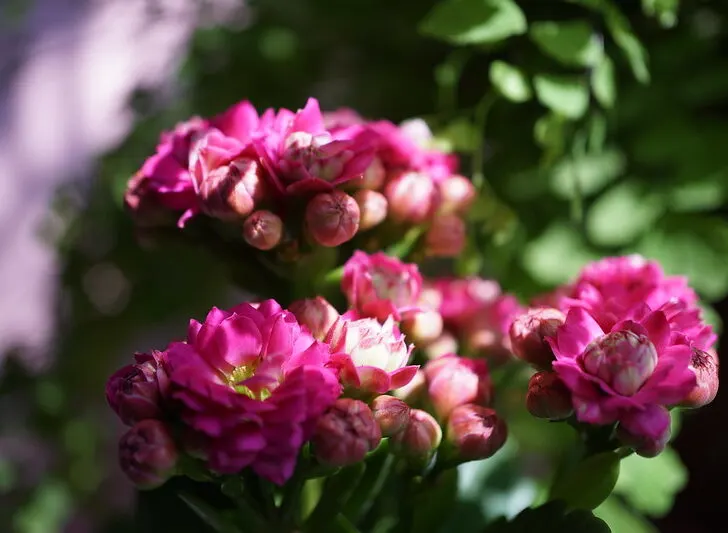
Kalanchoe blossfeldiana is a popular succulent among collectors and casual plant owners. It’s commonly called the flowering kalanchoe or florist’s kalanchoe for its prolific blooming capacity. Additionally, blooms are long-lasting and sprout often in the plant’s life.
Interestingly, this plant is a winter bloomer. It needs sunlight like any other plant, but giving it 14 hours of daily darkness will encourage flowering. Therefore, it works well for rooms without windows, like your bathroom.
Flower colors vary between individual plants. You can find specimens that sprout pink, white, yellow, orange, red, or purplish flowers.
24. Kalanchoe ‘Pink Butterflies’

Kalanchoe ‘pink butterflies’ is also commonly called the pink sparkler or mother of thousands. The plant looks similar to an aloe vera, except it hosts lines of tiny, delicate pink florets along each leaf.
Their tiny florets look like flowers, but they’re not. These florets are plant offshoots that lack chlorophyll (which means you can’t use them for propagation). The pink butterflies plant will also produce true flowers in spring.
Its true flowers are clusters of pink or red lantern-shaped flowers that hang downwards off of a stalk. Be aware that this plant is highly toxic to cats and dogs. The florets are frequently shed from the main plant, so be mindful about cleaning those up to protect your pet.
25. Mammillaria crinita ‘Pincushion Cactus’
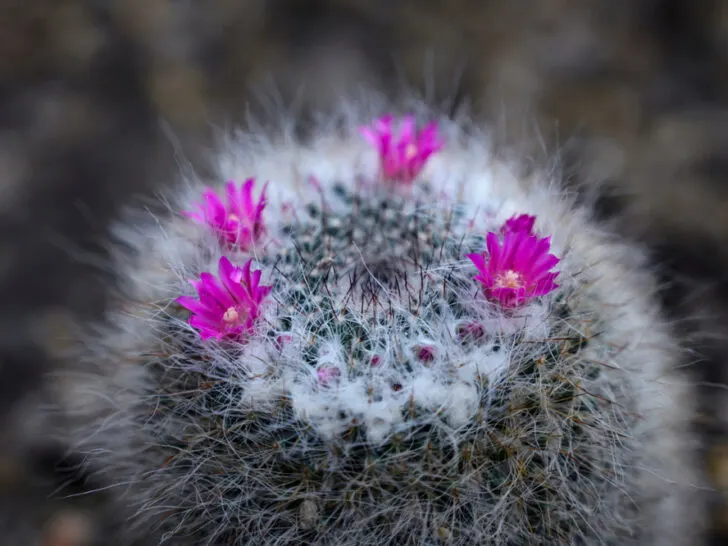
Mammillaria crinita is a spherical cactus, also known as the pincushion cactus. They can grow alone or in small clustered groups. Ball-shaped offshoots are common with any mammillaria cactus. Flowers grow on top of the cactus and come in many colors.
Depending on the individual plant, your pincushion cactus may produce yellow, white, pink, red, or purple flowers with darker-toned stripes. Flowers eventually turn into red, elongated fruits that look like hot peppers.
The fruit is edible, but it tastes nothing like hot peppers. These fruits are sweet and tart.
26. Oscularia deltoides ‘Pink Ice Plant’
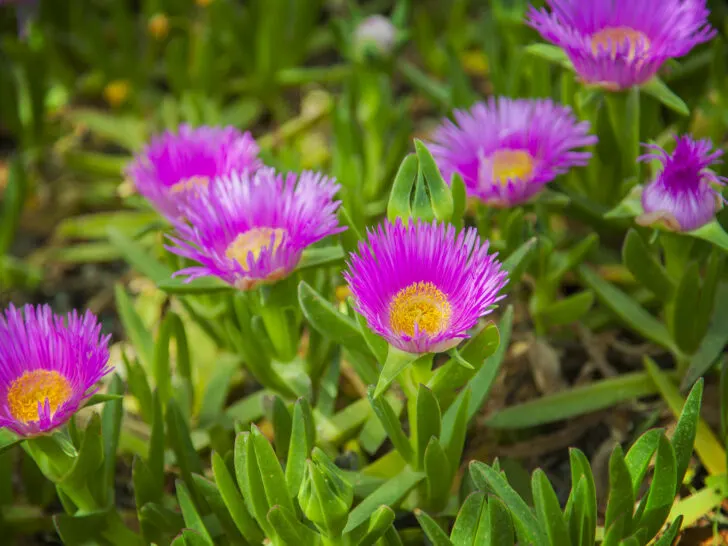
Oscularia deltiodes, or the pink ice plant, is a pale green succulent with pink flowers that bloom in summer or early fall. It has thick pyramid-shaped leaves outlined with soft spines. Their daisy-shaped flowers may also be red or purple.
This plant is shrub-like and can spread to a 24-inch (60 cm) diameter. During the blooming season, it will sprout lots of 2-inch (5 cm) wide flowers, making it look like a flower bed. This plant is an excellent way to add color to rocky landscapes.
As their name suggests, they can handle cooler temperatures. Therefore, you can leave them in your outdoor garden as the weather cools down.
27. Pachyphytum oviferum ‘Pink Moonstone’
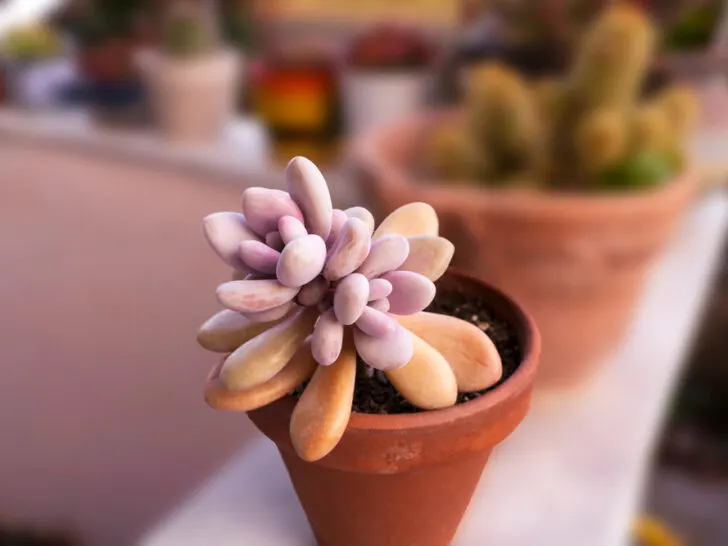
Pachyphytum oviferum gets the oviferum in its name from its bulbous egg-shaped leaves. Commonly called the pink moonstone, this is a tiny succulent that works best as a potted desk ornament. Orange, red, or pink lantern-shaped flowers may appear in spring.
Like many low-growing, rosette-shaped succulents, flowers appear on sprouted stems that grow between leaves. The stems are pinkish-orange to match the flowers, and each bloom is covered in a greenish “hood.” Like the main plant, these stalks won’t grow particularly tall.
28. Parodia haselbergii ‘Scarlet Ball Cactus’
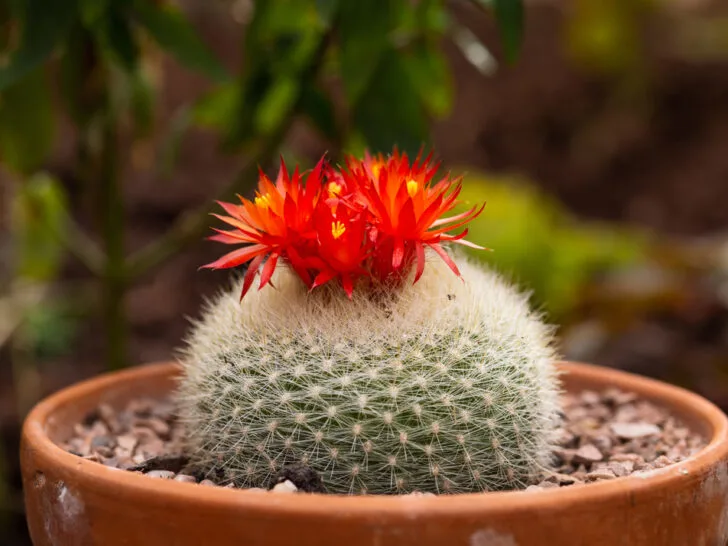
The scarlet ball is a grayish-green spherical cactus with a 5-inch (15 cm) diameter. This plant is native to Brazil and doesn’t like temperatures below 50 °F (10 °C). In late winter or early spring, it blooms large vivid orange flowers on its top.
Even though scarlet balls have a low cold tolerance, cooling them down in winter will encourage spring blooms. Aim for no lower than 41 °F (5 °C) to achieve this purpose.
I suggest keeping this plant indoors unless you live in a warm region like its Brazilian homeland.
29. Schlumbergera ‘Christmas Cactus’

The Christmas cactus or Thanksgiving cactus gets its name because it blooms in late fall or winter. However, early spring blooms may also occur. These blooms are trumpet-shaped hanging flowers that come in pink, purple, or red with white highlights.
Many people use them as an alternative to poinsettias. Both plants produce beautiful flowers throughout the holiday season. Unlike poinsettias, Christmas cacti are non-toxic. Making them a safer alternative around cats and dogs. They’re also significantly easier to care for.
30. Sedum rubrotinctum ‘Jelly Bean’
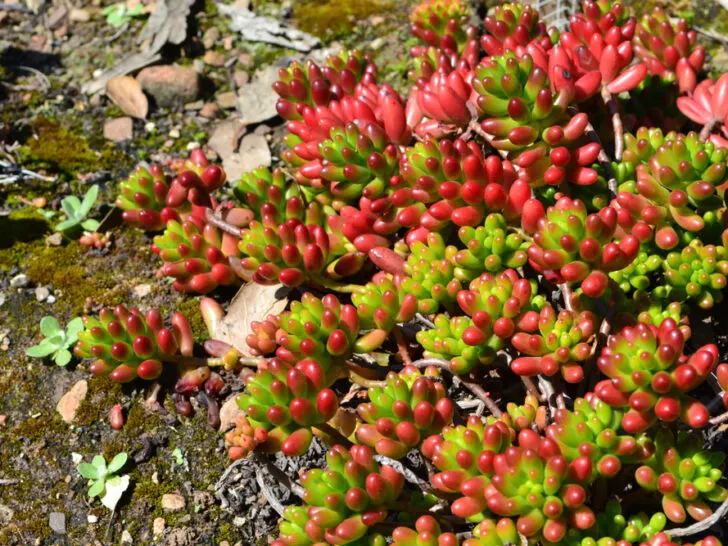
The jelly bean plant is also commonly called pork and beans. These nicknames refer to their small bean-like leaves. They’re also commonly called Christmas cheer because their leaves are typically green with red tips.
Following the Christmas theme, this plant produces small delicate star-shaped yellow flowers, although these little stars miss the holiday season because they bloom in spring. Flowers grow in tight clusters at the top of each branch.
Jelly bean plants are toxic to humans and animals and can irritate the skin. Keep them away from children and pets, and always wear gloves when you handle them.
31. Sempervivum arachnoideum ‘Emily Cobweb Houseleek’

Sempervivum arachnoideum is commonly called Emily cobweb houseleek, the cobweb houseleek, spider hens and chicks, cobweb hens and chick, or just Emily. It gets its name from its white hair-like spines that look like cobwebs.
Blooms occur in late summer and fall. The base rosette will sprout scaly dark green stems that produce dark pink star-shaped flowers with deep brown centers. Blooms won’t happen until the plant is older, but you can accelerate the process by stressing them.
Conclusion
Succulents are diverse plants. Their unique look attracts plant enthusiasts, and their low-maintenance nature attracts casual owners and interior decorators. Still, flowers are one of the most decorative features of any plant species.
With these flowering succulents, collectors and decorators alike can experience all the beauty of flowers with the easy nature of succulents.

